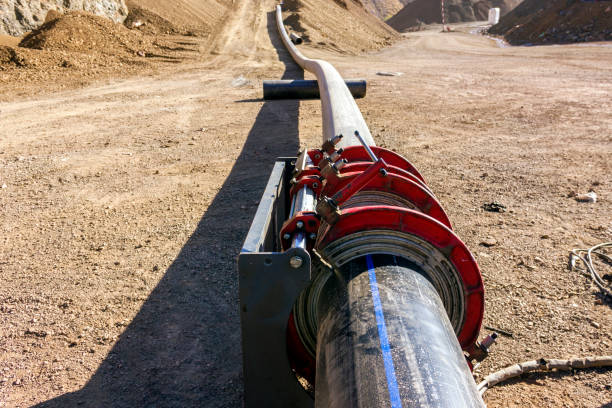When discussing pipeline construction and water management systems, one of the most frequently asked questions is what type of welding is used for HDPE pipe. High-Density Polyethylene (HDPE) is widely chosen for pipelines because of its flexibility, durability, and resistance to chemicals and corrosion. However, unlike metals, HDPE cannot be joined by traditional methods such as arc welding. Instead, it requires specialized plastic welding techniques designed to create strong, leak-free joints that can withstand the demands of fluid transportation. Understanding these welding methods is essential for engineers, contractors, and project managers who want to ensure long-term reliability in their piping systems.
The most common technique for joining HDPE pipes is butt fusion welding. In this method, the pipe ends are heated with a specialized tool until they reach the right melting temperature. Once softened, the ends are pressed together under controlled pressure, allowing the molten material to fuse into a single continuous piece. This process results in a joint that is as strong as, or sometimes even stronger than, the pipe itself. Butt fusion welding is widely used in large-diameter pipelines for water supply, sewage treatment, and industrial fluid transport because it provides seamless connections with minimal risk of leakage.

Another widely adopted method is electrofusion welding. This technique uses fittings embedded with electrical heating coils. When current is applied, the coils generate heat that melts the surface of both the pipe and the fitting, creating a secure and homogeneous joint. Electrofusion is particularly valuable in situations where space is limited, such as in trench installations or repairs. Its ease of use and precision make it popular for gas distribution and water pipelines in urban environments. Compared with butt fusion, electrofusion may be more costly because of the specialized fittings, but it provides reliable performance where conventional fusion is impractical.
In addition to these, extrusion welding is sometimes employed, especially for fabricating HDPE sheets into tanks, liners, or custom components. This process involves heating plastic filler material and extruding it into a joint while pressing it against the surfaces to be welded. Though less common for long pipelines, extrusion welding is useful for repairs, smaller pipe diameters, or when a customized weld is necessary. For contractors dealing with non-standard structures, extrusion welding offers flexibility and adaptability.
For certain applications, particularly temporary connections or installations in challenging environments, socket fusion welding is also used. This technique involves heating both the outside of the pipe and the inside of a fitting simultaneously before joining them together. The method is straightforward and does not require the same scale of equipment as butt fusion. It is commonly applied in smaller pipe systems where speed and efficiency are important. Though it may not be suitable for very large pipelines, socket fusion provides a practical and reliable option for residential and light industrial projects.
Each of these methods comes with its own requirements in terms of equipment, operator training, and quality control. For example, butt fusion welding demands precise alignment of the pipes and careful control of heating and cooling times. Electrofusion, while simpler in execution, requires accurate surface preparation, including cleaning and scraping of pipe ends, to ensure a strong bond. Even minor deviations in procedure can lead to weak joints, so skilled workmanship and adherence to standards are critical across all techniques.
Users also often wonder about the advantages of welding over mechanical joints when working with HDPE. Unlike flanged or bolted connections, welded joints create a homogenous pipeline that eliminates potential weak points. This is especially important for applications involving high-pressure systems or underground installations, where joint failure could cause costly damage and service interruptions. The leak-free nature of welded HDPE systems is one of the main reasons they are increasingly replacing traditional materials like steel, concrete, or PVC in modern infrastructure projects.
Another factor influencing the choice of welding method is pipe diameter and project scale. For pipelines with large diameters, butt fusion is generally the most efficient and economical choice. On the other hand, electrofusion is more practical for smaller diameters or when connections must be made in confined spaces. In projects that involve repairing existing lines, extrusion welding or socket fusion may be the most effective solution. Therefore, the selection of welding technique often depends not only on technical performance but also on the specific requirements of the site and project budget.
In addition to the welding methods themselves, inspection and testing play an important role in ensuring the quality of HDPE pipe joints. Techniques such as visual inspection, pressure testing, and non-destructive evaluation are commonly used to confirm the integrity of the welds. These checks are vital for industries like gas distribution, where safety and compliance with standards are paramount. A reliable welding process combined with thorough inspection significantly reduces the risk of failures and extends the service life of the pipeline.
It is also worth noting that environmental conditions can influence the choice and execution of welding methods. For instance, in very cold climates, maintaining consistent heating during butt fusion can be challenging, requiring additional precautions such as protective tents or heaters. In contrast, electrofusion may perform better under such conditions because of its controlled, localized heating. Contractors must therefore consider not only the pipe specifications but also the surrounding conditions when planning HDPE welding operations.
From a long-term perspective, proper welding methods contribute to the cost-effectiveness of HDPE pipelines. Although the initial investment in equipment and training may be significant, the durability and low maintenance of welded HDPE systems often offset these costs. Their resistance to corrosion and reduced need for repair mean lower operational expenses over decades of service. This economic benefit, combined with environmental advantages like reduced water loss and energy efficiency, makes HDPE welding a sustainable choice for infrastructure projects.
In summary, while there are several approaches to joining HDPE pipes, the choice of welding method depends on factors such as pipe size, project conditions, and performance requirements. Techniques like butt fusion, electrofusion, extrusion welding, and socket fusion each provide unique benefits that meet different needs. What unites them is their ability to produce strong, leak-proof joints that support the growing demand for reliable and sustainable piping systems across industries.


